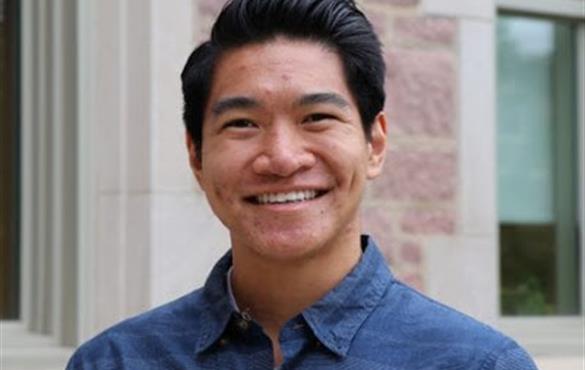BME PhD student featured in SPIE photonics blog
Cristopher Pacia was highlighted as one of the organization's #FacesofPhotonics thanks to his work with ultrasound imaging and therapy

See his post on the Photonics for a Better World website.
Why haven't we found a cure for cancer yet? This is the question that motivates Christopher Pacia when he's doing research in the Chen Ultrasound Lab at Washington University in St. Louis (WUSTL). Pacia is a PhD student in biomedical engineering, and his research focuses on ultrasound imaging and therapy that can impact cancer patient care. "With a greater understanding of the brain, treatments can be more patient-specific," says Pacia. "In that way, they will also be more effective in improving the lives of those affected by the seemingly boundless complexity of neurological disorders."
Pacia is the current Vice President of the SPIE Student Chapter at his university, under the supervision of 2019 SPIE Britton Chance Award winner, Dr. Samuel Achilefu. The chapter is involved in a variety of local outreach activities which, according to Pacia, is one of the most rewarding parts of being a researcher.
Enjoy SPIE's Faces of Photonics interview with Chris!
1. Share the story of your favorite outreach experience.
One of my favorite outreach experiences was my trip to the local St. Louis Science Center during its annual SciFest event. SciFest is free and open to the public, and it's where scientists, engineers, and doctors come together to show all the amazing things happening around St. Louis. Hundreds of attendees have the chance to walk around and learn about motion-capture technology in movies, how memories are formed in the brain, and how optics acts as a window into our bodies.
Our SPIE Student Chapter went to SciFest to put on an exhibit, showing children and adults the science behind ultrasound imaging. Our booth had hands-on demonstrations to showcase the fundamentals of sound, and the ways in which ultrasound can be used for imaging. We even let the brave, young scientists try to image their own arm! The kids loved playing with sound and trying to see what they look like on the inside. Even adults were amazed when we explained how fetal ultrasound images were formed. The amount of shock and awe that comes from building an understanding in science has been one of the most rewarding parts of being a researcher.
2. Explain your current research and what you do at your job. How does your work impact society?
A question people are always asking is: Why haven't we found a cure for cancer yet? But, of course cancer research isn't as straightforward and simple as we would hope, especially in the case of brain cancer. The main challenge when treating brain cancer is the presence of the blood-brain barrier (BBB). The BBB has the important task of regulating the diffusion of molecules between the brain and blood vessels. While this is beneficial in protecting neural tissue from foreign pathogens, the BBB also prevents life-saving drugs from being delivered to the brain.
In the Chen Ultrasound Lab at WUSTL, we are working with focused ultrasound (FUS) to non-invasively disrupt the BBB and enhance drug delivery to the target area. The integration of FUS with magnetic resonance imaging (MRI) allows for more precise targeting, so by developing an integrated FUS system, clinicians will be able to use their MRI scanners to non-invasively enhance cancer-drug delivery. This will take us one step closer to developing a cure for cancer.
3. When you look five years into the future, what do you hope to have accomplished?
In five years, I hope to have completed my PhD research and be involved with further developing diagnostic and therapeutic tools for the clinic. The necessity for this technology is clear, and with my training I plan on making great strides to improve patient care. My goal is to have developed a system that can help answer at least one question about the brain. Whether it has to do with remapping after disease, the effects from aging, or the enhancement of cognitive processes from neuromodulation, I will want to have my hand in a revolutionary tool that will shape the future of science.
On a more personal level, I'd like to influence the future generations of scientists. The next generation of researchers will have a greater amount of resources, technology, and mentors at their disposal to address any unanswered questions. I will continue to reach out in my community to share what I have learned, and, hopefully, inspire students to pursue a STEM career and push the envelope of science. If I persuade just one student, the five years will have been worth it.
4. What is your advice to others in the STEM community?
Building a diverse community and sharing knowledge with each other will push STEM further into the future. There have been great strides in the scientific community in terms of reaching out and encouraging underrepresented minorities to pursue STEM careers. There has been a lot of progress, but it cannot stop there.
There are a number of ways to help. To name a few: going out into local schools and showing students that science is fun is the catalyst to helping students recognize their potential; providing students with the resources to run hands-on experiments will prepare them for a future career in STEM; putting on demonstrations at the science center will help students appreciate how science is used in our everyday lives.
